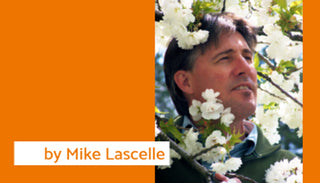There is something about the concept of plants growing in water that seems to intimidate some gardeners. Truth be told, aquatic plants can be accurately described in just two phrases:
1. how deep, and
2. hardy or tropical

The first statement dictates the water depth that these species can tolerate, while the second is simply an indication of whether or not the plant is tender seasonal colour or cold hardy, as indicated by the hardiness zone provided. Many aquatic suppliers have made this quite easy by providing a detailed plant tag that when flipped over reveals the ideal sun exposure, bloom period (if applicable), water depth (over the crown), and hardiness zone (zones 1-7 are hardy in the Fraser Valley, while 8 and up are not).
I am going to take this a little further by providing you with a brief overview of aquatics and their respective plant groups, as well as potential landscape uses.
Bog Plants
These are usually plants that thrive on the edge of the pond, which tolerate temporary flooding and require even moisture at all times. You don’t even need to shop the aquatic section of the nursery as many common perennials such as Astilbe, Ligularia, Ferns (Onoclea, Osmunda, and Ostrich Fern), and some Primula (P. bulleyana and Siberian Iris) thrive under these conditions. For a dramatic backdrop for larger ponds, try Giant Rhubarb or Gunnera manicata, although the crown will require some winter protection.
Floaters
As the name indicates, these are plants that float on the surface of the water and are useful for shielding fish from predators (primarily Blue Herons), shading the water, and helping to draw up excess nutrients that unwanted algae thrive on. Most are tropical in nature, including Water Hyacinth (Eichhornia crassipes), which blooms late summer, Floating Fern (Salvinia natans), and Water Lettuce (Pistia stratiotes). These are introduced to the water feature or pond in May and perish with the frosts (when they should be removed and thrown into the compost). Hardier options include our native Duckweed (Lemna minor), Fairy Moss (Azolla caroliniana), and Frogbit (Limnobium spongia), all of which will go dormant in the cold.
Marginals
These plants grow in the margins or shallows of the pond and tolerate water depths ranging from 1-12” over the crown, depending on the species. This includes very colourful perennials such as Marsh Marigold (Caltha palustris [up to 4” deep]), Blue Flag (Iris versicolor [2-4” deep]), Chameleon Plant (Houttuynia cordata ‘Chameleon’ [0-1” depth]), Variegated Cattail (Typha latifolia ‘Variegata’ [4-12” deep]), and Golden Club (Orontium aquaticum [6-18” deep]), all of which go dormant for winter. Pay close attention to the suggested crown depth as plunging them too deeply may cause their demise.
Deep Water Aquatics

Nelumbo 'Momo Botan'
Defined as true aquatics that tolerate water depths exceeding 12- to18-plus inches, which include flowering perennials such as Hardy Waterlily (Nymphaea) and the hard-to-find Lotus (Nelumbo), as well as oxygenators such as the tender Red-Stemmed Parrot’s Feather (Myriophyllum brasiliensis [zone 9]), which is a much better choice than the invasive Myriophyllum aquaticum (zone 6). Lotus has stunningly beautiful blossoms that stand just above the water, but you definitely need a greenhouse pond to be successful with it in coastal B.C. Your better choices are the hardy water lilies (zone 4) with floating flowers in yellow (‘Chromatella’), white (‘Gonnere’), peach (‘Clyde Ikins’), pink (‘Mayla’), purplish-red (‘Almost Black’), as well as dwarf forms (‘Perry’s Baby Red’) which all bloom from June to September with proper fertilization.
Tropical Fringe
These are non-hardy plants that add eye-catching foliage or flowers to the pond, that can only be over-wintered indoors or if sheltered in a frost-free sunroom. Included here are Canna Lilies, Papyrus (Cyperus), Hardy Ginger (Hedychium), Taro (Colocasia), and Cranberry Hibiscus (H. acetosella). A particularly beautiful but difficult to find tropical aquatic is Mosaic Plant (Ludwigia sedioides) that features rounded clusters of tiny green and red floating leaves that prefer warmer waters of 21-24C (70-75F).
Container Culture
Truth be told, you don’t need a pond to enjoy aquatic plants, as any waterproof container (no drain holes) will do. Size also doesn’t matter as these can range from tabletop features to large square planters tucked on the edge of the patio. The trick is to get the contrast and scale right, using highly textured plants such as Spiral Rush (Juncus effusus ‘Spiralis’), dwarf Papyrus or ‘Bowles Golden’ Sedge (Carex elata ‘Aurea’), contrasted by a smaller-scale floater like Salvinia. Small tabletop water bowls can feature solitary plants or even a simple combination of Mare’s-Tail (Hippuris vulgaris), which looks like a tiny grove of conifers, with Moneywort (Bacopa monnieri) that bears white to pale blue flowers from late April to September.
Avoiding Invasives
I would like to end with a quick note on two invasive aquatics that we find here in Pitt Meadows. Both Iris pseudacorus (aka Yellow Flag) and Parrot’s Feather (Myriophyllum aquaticum) can be found thriving in our local sloughs and ditches where it is overwhelming native aquatics. While no longer sold in garden centres, these are often shared among gardeners but are best avoided altogether.
Well, that ends our quick overview of what’s available in aquatics and where to plant them, but I encourage you to visit Amsterdam Garden Centre and peruse our much broader plant selection.


